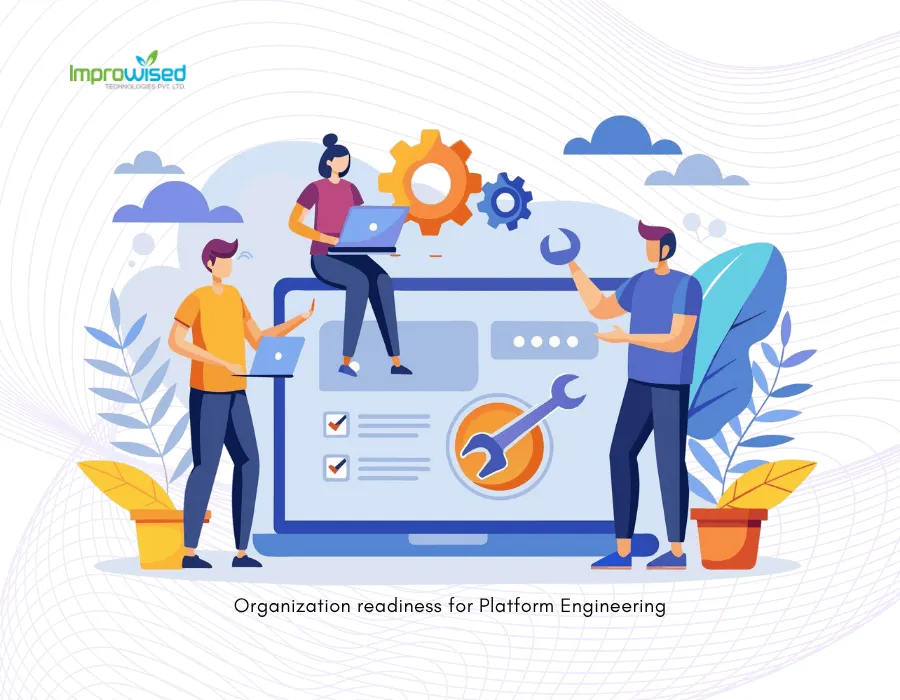September 17, 2025
Versioning Infrastructure Components for Safer Rollbacks and Deployments

By Improwised Editorial Team
Improwised Technologies Pvt. Ltd.
In systems where uptime and tolerance for failure are the defining qualities of “working,” versioning infrastructure components is not merely a design consideration; it is a requirement of design. Whether any change is made to compute instances, networking infrastructure, container orchestration logic, or declarative code that defines infrastructure, the ability to version, inspect, and rollback is a key aspect of operational control. If versioning processes are not followed, rollback processes may become unreliable, and a deployment may warrant some risk with no option to rollback. This post explains how infrastructure versioning can enable rollback and decoding in a controlled manner, the mechanisms for implementing it, and the operation workflows necessary to ensure safe deployments across environments.
Version Control for Infrastructure: Not Just for Source Code
While version control systems such as Git or other version control methodologies are often used for application code, adopting these practices for infrastructure does require consistent and common structuring of declarative definitions. Tools such as Terraform, Pulumi, and AWS CloudFormation are tools with infrastructure as code support, but not all of those tools have version-aware rollback processes built into the. To address the gap, organizations will need to implement their version tracking for infrastructure modules, state representation, and execution plans.
Infrastructure versioning should include three important aspects:
Configuration Files (for example: Terraform .tf’s, Helm charts, Ansible playbooks)
State Files (representing current deploys)
Deployed artifact versions (for example: container image tags, AMI ids, runtime package)
For each of the elements of versioning, it must be immutable, reproducible, and traceable. Without immutability and traceability, our roles will not represent the operational capability to investigate the incident or roll back a failed project.
Declarative Infrastructure and Version Pinning
Declarative models enable predictable infrastructure provisioning, but rather than incorporating rollback guarantees, they describe what should exist rather than how to create it. In order to deliver rollback guarantees, version pinning needs to be applied rigorously.
As an example, for Terraform-based workflows, every module and provider should be pinned to a specific version. To allow non-pinned versions to be used or when using floating references, latest or even wildcard constraints (~>, ^), create non-determinism in state resolution and plan generation. If there is an incident and you reapply the infrastructure, then you might reach a different state than the original, which impedes recovery.
To help enforce consistency:
- Module sources must always be pinned using commit hashes or version tags
- Container images must always be referenced using their immutable digests (sha256), not tags
- Runtime dependencies should be declared in lock files with checksums (i.e. requirements.lock, Pipfile.lock)
Applying infrastructure from a known state should result in deterministic resources being created. This is fundamentally required for reliable rollbacks.
Artifact Versioning and Promotion Strategy
Infrastructure deployments will always touch one or more application artifacts. If the infrastructure change being applied will deploy a new container image or virtual machine image, then the image must also be versioned and must live in a registry that can support retention and reproducibility. The promotion strategy should reflect the application CI/CD pipelines:
Build and tag artifacts with unique, immutable identifiers
Store these artifacts in a versioned registry (e.g., Docker Registry, S3, AMI catalog)
Promote artifacts up through a staging, canary, then production environments, by simply updating references to versions within the infrastructure definitions.
This model allows for rollback by simply re-pointing infrastructure to earlier versions of the artifact with no chance of modifying the underlying template logic. Tools such as FluxCD and ArgoCD in Kubernetes environments will take advantage of this model to leverage the model of GitOps by synchronizing desired states.
Rollback Design: Forward-Fix vs Reverse-Apply
There are two primary ways to do a rollback:
Forward-fix: A new change is deployed that “undoes” the negative effects of a problematic release
Reverse-apply: The previous known good version is redeployed
In a forward-fix model, we likely assume that our failure was diagnosed in a very timely manner, and the fix could be authored and deployed with high confidence. However, this often takes engineering time, by way of testing cycles, and it is not useful in time-critical outages.
In reverse-apply, you rely on having a recorded version reference of your artifacts and infrastructure for the build. This can be done indirectly by way of:
Git tags or commits of known-good infrastructure definitions.
Terraform state history and prior state files.
Helm releases or Kubernetes manifests are saved in a central controller.
There are tools like Terraform that natively support state snapshots but not state rollback. Engineers will need to apply a previous set of configurations in conjunction with a preserved state reference. While kubectl rollout undo in Kubernetes provides an easy way to reverse Deployments, you must manually create similar methods for lower-level components like persistent volume configurations or service meshes.
Version-Aware Deployment Capabilities
To safely execute versioned deployments, the deployment system must be version-aware at the orchestration level. That is:
- Version labels must be added to resources when created.
- Deployment workflows must log the versions and results of the versioned deployments.
- Observability tools must label metrics and logs with version information.
When a deployment system is version aware, engineers can correlate performance degradation, error rate spikes, or outages with particular infrastructure versions. This can be particularly important in a multi-tenant/shared environment where configuration drift or potential side effects may obscure the root cause.
In addition, the deployment pipeline must enforce environment isolation. Promoting infrastructure changes through dev → staging → production without introducing variations in the version references enforces reproducibility. Drift detectors can compare the live states with version-controlled definitions and discover drift before the changes go to production.
Dealing with State Drift and Blog for Resources that Provide No Versioning
Other infrastructure components are challenging to version or rollback because they depend on external systems, mutable state, or third-party APIs. Examples include:
- DNS zones that are managed through external providers and allow edits to be made out of band,
- Load balancers that may have partial configurations made through GUI tools, or
- Secrets that are stored in external vaults can be modified outside of an IaC workflow.
For these infrastructure components, drift detection and reconciliation processes are necessary. Infrastructure scanners are able to confirm that the reality matches what is defined. If not, either automated reconciliation must occur or alerting must occur in order to escalate to it.
In order to lessen the risk of getting stuck in a change with no way out, always take backups and snapshots before every deployment. These tasks include exporting DNS zone files, taking snapshots of overall databases or block volumes, and dumping configurations through CLI tools.
Without these practices, rollbacks become risky to the story when a state does not exist or is incompatible.
Automated triggers and guardrails to roll back
To reduce human reliance on high-risk deployments, rollback triggers and guardrails can be integrated with systems for monitoring and alerting.
- Some things include: Threshold-based trigger: If error rates go above a defined level of service (SLO) in a defined time window following deploy, trigger a rollback
- Canary analysis: Stop their deployment if canary instances show a degrading trend of any metric
- Manual approval: Many systems, at least, can’t allow an operator to promote a deploy to production without approval or the metrics they see.
These possible rollback triggers and guardrails can only be employed if infrastructure is versioned for all its definitions across its states and objects. Without versioned infrastructure for rollback, automation cannot determine when to roll back and will need to find ways to be manually remediated.
Conclusion
Unversioned infrastructure creates systemic fragility. When a deploy fails, an operator has nowhere to roll back to. When bugs are found after a deploy, it turns into a guessing game to find the root cause. When there is a drift in configuration between environments, then those objects that can become versions for testing are not tested in the least consistent manner, which increases the exposure to mistakes when deploying. This all comes at a cost; it increases downtimes, it potentially increases human error, and it reduces trust in our deployment practices.
Rollback is not a process - it is a capability. That capability comes seamlessly from infrastructure versioning across objects, definitions, and states. When organizations do not favour strict versioning and rollback approaches, they leave themselves exposed to operating in regressed states with no way back, with a lot of energy undertaking manual work ahead of them. In some cases, Unversioned deployments may create artifacts or changes that cannot be undone -such as key revocation, or database schema changes, where they cannot be rolled back without hitting things like downtime or causing data loss.
Implementing a regular, routine way of governing versioning should no longer be seen as an optional regime, especially when future changes to infrastructures need to be reversible. This is what underpins any viable practices around deployment practices.

November 7, 2025
How to Troubleshoot Kubernetes: Identify and Fix Issues Like a Pro

By Shyam Kapdi
Improwised Technologies
Pvt. Ltd.

November 5, 2025
7 Signs Your Organization Needs Platform Engineering

By Priyank Dhami
Improwised Technologies
Pvt. Ltd.


By Shyam Kapdi
Improwised Technologies
Pvt. Ltd.
Optimize Your Cloud. Cut Costs. Accelerate Performance.
Struggling with slow deployments and rising cloud costs?
Our tailored platform engineering solutions enhance efficiency, boost speed, and reduce expenses.
